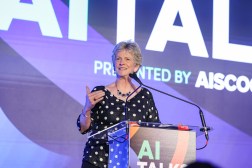 Data.gov as it looks today.
Data.gov as it looks today.When Data.gov was established in 2009, it was considered an experiment in open government. Now, with more than half a million unique data resources on the website, it’s transitioned into a proactive resource for data enthusiasts, public and private alike.
“We work hard to push as much data up and out and to try to be as responsive and proactively go out and work with communities around the country and around the world,” Jeanne Holm, Data.gov’s evangelist, told FedScoop. “[Over time] we just worked really hard to take it as far as we could.”
 Jeanne Holm, evangelist for data.gov
Jeanne Holm, evangelist for data.govContributed Photo
Holm, who also works as the chief knowledge architect at NASA’s Jet Propulsion Laboratory, has been on board with the Data.gov project since 2009, when newly-appointed federal Chief Information Officer Vivek Kundra started the initiative.
Since its inception as a transparency initiative, the site has developed into an information repository and resource. Each day, the Data.gov team, which consists of four people and is based out of the General Services Administration, pulls data from agencies, universities and other research entities who have made their data available for federation, Holm said.
“I can’t tell you in any given day how many data sets there are because it’s truly dynamic and we bring in city, county and state data when it’s made available to us as well,” Holm said. “We obviously don’t tell cities and states how to spend their money, but if they have open data sites, we can reach out to them and ask them if they want to be federated.”
Somewhere along the way, the team of data enthusiasts who work on the site realized it was about more than transparency — it was part of a bigger ecosystem.
“The Field of Dreams doesn’t really work,” Holm said. “If you build it, they won’t necessarily come. So, you have to plow the fields and build the roads to it and make sure there are big neon signs that say ‘Field of Dreams right here.’”
And bringing people to the Field of Dreams is Holm’s job, she said. The data evangelist does more than just make sure agencies know how to publish data and why it’s important to publish data; it also works with several different points of contact within the 135 agencies who contribute data to the website.
Additionally, Holm works with the Small Business Administration to encourage entrepreneurs to take advantage of the vast resource of data for what could be the next great business.
 Users can search by category on data.gov to get cross-agency data sets and in case the user does not know which agency to search for for a particular piece of data.
Users can search by category on data.gov to get cross-agency data sets and in case the user does not know which agency to search for for a particular piece of data.“Through ongoing interactions, we have communities of practice behind each of the topical areas on the website,” Holm said. “We have people inside and outside the government that help us to contact and connect with and collaborate with lots of people from across the country working in many different sectors to figure out what different people need.”
Holm, through one of the newest data sets available on the website, also tries to bring attention to the more than 700 facilities available across the government for any U.S.-based manufacturers to use as a test facility for a product.
“Anything from a wind tunnel to a lab bench, so that people in the local community who say ‘Oh, I have a business. I wish I had the ability to test something, but that test chamber costs more than my entire business,’” Holm said. “Anything you do suddenly makes you able to innovate and try some out of the box things that you would never have been able to afford as an individual.”
In May 2013, the website became fully open source, just a year after the site’s source code was posted on GitHub. According to Holm, the move to open source came alongside a collaboration with the governments of India, Canada and Ghana to look at how coding together can allow each country’s open data initiatives to operate with fewer resources.
“Together we share code, we meet every month and we co-develop the back end of our data portal,” Holm said. “It’s been really great looking at that whole aspect of international collaboration that helps with government efficiencies. We have a better portal because we don’t have to develop it ourselves.”






